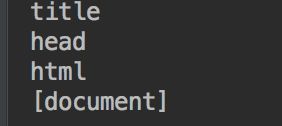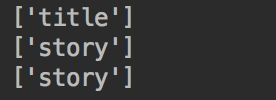Python3中beautifulsoup库的使用(爬虫利器)
Beautiful Soup 库简介
Beautiful Soup提供一些简单的、python式的函数用来处理导航、搜索、修改分析树等功能。它是一个工具箱,通过解析文档为用户提供需要抓取的数据,因为简单,所以不需要多少代码就可以写出一个完整的应用程序。
Beautiful Soup自动将输入文档转换为Unicode编码,输出文档转换为utf-8编码。你不需要考虑编码方式,除非文档没有指定一个编码方式,这时,Beautiful Soup就不能自动识别编码方式了。然后,你仅仅需要说明一下原始编码方式就可以了。
Beautiful Soup已成为和lxml、html6lib一样出色的python解释器,为用户灵活地提供不同的解析策略或强劲的速度。
标签选择器
- 选择元素
from bs4 import BeautifulSoup
html = """
The Dormouse's story
The Dormouse's story
Once upon a time there were three little sisters; and their names were
,
Lacie and
Tillie;
and they lived at the bottom of a well.
...
"""
soup = BeautifulSoup(html,'lxml')
print(soup.title)#选择title标签中的内容
print(type(soup.title))#title标签的类型
print(soup.head)#head标签中的内容
print(soup.p)#第一个p标签中的内容
返回结果:

soup.标签名可以选择所需要的标签中的内容,返回结果是Tag类型。它查找的是在所有内容中的第一个符合要求的标签,例如上面的
的内容。
如果要查询所有的标签,在后面进行介绍。
- 获取名称
from bs4 import BeautifulSoup
html = """
The Dormouse's story
The Dormouse's story
Once upon a time there were three little sisters; and their names were
,
Lacie and
Tillie;
and they lived at the bottom of a well.
...
"""
soup = BeautifulSoup(html,'lxml')
print(soup.title.name)
- 获取属性
from bs4 import BeautifulSoup
html = """
The Dormouse's story
The Dormouse's story
Once upon a time there were three little sisters; and their names were
,
Lacie and
Tillie;
and they lived at the bottom of a well.
...
"""
soup = BeautifulSoup(html,'lxml')
print (soup.p.attrs['name'])
print(soup.p['name'])
返回结果:

在这里,我们把 p 标签的name属性的值打印出来了,name的值为dromouse,上面两种使用方法是等价的。
- 获取内容
from bs4 import BeautifulSoup
html = """
The Dormouse's story
The Dormouse's story
Once upon a time there were three little sisters; and their names were
,
Lacie and
Tillie;
and they lived at the bottom of a well.
...
"""
soup = BeautifulSoup(html,'lxml')
print (soup.p.string)
使用标签的.string方法可以轻松获得当前标签中的内容。
- 嵌套选择
from bs4 import BeautifulSoup
html = """
The Dormouse's story
The Dormouse's story
Once upon a time there were three little sisters; and their names were
,
Lacie and
Tillie;
and they lived at the bottom of a well.
...
"""
soup = BeautifulSoup(html,'lxml')
print (soup.head.title.string)
返回结果:

可以通过嵌套几个不同的标签,层层迭代来获取他的内容,属性,名称。
- 获取子节点
.contents方法:
from bs4 import BeautifulSoup
html = """
The Dormouse's story
The Dormouse's story
Once upon a time there were three little sisters; and their names were
,
Lacie and
Tillie;
and they lived at the bottom of a well.
...
"""
soup = BeautifulSoup(html,'lxml')
print(soup.p.contents)
返回结果:

.content 属性可以将tag的子节点以列表的方式输出,输出方式为列表,我们可以用列表索引来获取它的某一个元素,如:
print soup.head.contents[0]
#返回结果:The Dormouse's story
.children方法:
print soup.head.children
#返回结果:
他返回一个迭代器对象,可以通过遍历获得其中的子节点,如:
from bs4 import BeautifulSoup
html = """
The Dormouse's story
The Dormouse's story
Once upon a time there were three little sisters; and their names were
,
Lacie and
Tillie;
and they lived at the bottom of a well.
...
"""
soup = BeautifulSoup(html,'lxml')
print(soup.head.children)
for child in soup.body.children:
print (child)
- 获取子孙节点
from bs4 import BeautifulSoup
html = """
The Dormouse's story
The Dormouse's story
Once upon a time there were three little sisters; and their names were
,
Lacie and
Tillie;
and they lived at the bottom of a well.
...
"""
soup = BeautifulSoup(html,'lxml')
for child in soup.body.descendants:
print (child)
以上代码可以获取到head标签的所有子孙节点中的内容。
.descendants返回的是一个迭代器的类型,可以通过遍历输出所有的结果。
- 获取多个内容
.strings 获取多个内容,不过需要遍历获取,比如下面的例子
from bs4 import BeautifulSoup
html = """
The Dormouse's story
The Dormouse's story
Once upon a time there were three little sisters; and their names were
,
Lacie and
Tillie;
and they lived at the bottom of a well.
...
"""
soup = BeautifulSoup(html,'lxml')
for string in soup.strings:
print(repr(string))
返回结果为:
"The Dormouse's story"
'\n'
'\n'
"The Dormouse's story"
'\n'
'Once upon a time there were three little sisters; and their names were\n'
',\n'
'Lacie'
' and\n'
'Tillie'
';\nand they lived at the bottom of a well.'
'\n'
'...'
'\n'
发现将所有标签的内容返回了出来,但是也有许多空的标签,也会进行返回,如果想过滤空行,可以使用.stripped_strings 函数。
.stripped_strings 输出的字符串中可能包含了很多空格或空行,使用 .stripped_strings 可以去除多余空白内容
from bs4 import BeautifulSoup
html = """
The Dormouse's story
The Dormouse's story
Once upon a time there were three little sisters; and their names were
,
Lacie and
Tillie;
and they lived at the bottom of a well.
...
"""
soup = BeautifulSoup(html,'lxml')
for string in soup.stripped_strings:
print(repr(string))
返回结果为:
"The Dormouse's story"
"The Dormouse's story"
'Once upon a time there were three little sisters; and their names were'
','
'Lacie'
'and'
'Tillie'
';\nand they lived at the bottom of a well.'
'...'
这样就避免了空行和空格的出现。
- 获取父节点
.parent 属性 获取此标签的上一层标签
from bs4 import BeautifulSoup
html = """
The Dormouse's story
The Dormouse's story
Once upon a time there were three little sisters; and their names were
,
Lacie and
Tillie;
and they lived at the bottom of a well.
...
"""
soup = BeautifulSoup(html,'lxml')
p = soup.p
print (p.parent.name)
- 获取祖先节点
.parents 属性
from bs4 import BeautifulSoup
html = """
The Dormouse's story
The Dormouse's story
Once upon a time there were three little sisters; and their names were
,
Lacie and
Tillie;
and they lived at the bottom of a well.
...
"""
soup = BeautifulSoup(html,'lxml')
content = soup.head.title.string
for parent in content.parents:
print (parent.name)
输出结果为:

通过元素的 .parents 属性可以递归得到元素的所有父辈节点
- 获取兄弟节点
.next_sibling 获取此标签后面的节点
.previous_sibling 获取此标签前面的节点
from bs4 import BeautifulSoup
html = """
The Dormouse's story
The Dormouse's story
Once upon a time there were three little sisters; and their names were
,
Lacie and
Tillie;
and they lived at the bottom of a well.
...
"""
soup = BeautifulSoup(html,'lxml')
print (soup.p.next_sibling)
# 实际该处为空白
print (soup.p.prev_sibling)
#None 没有前一个兄弟节点,返回 None
print (soup.p.next_sibling.next_sibling)
输出结果为:

兄弟节点可以理解为和本节点处在统一级的节点,.next_sibling 属性获取了该节点的下一个兄弟节点,.previous_sibling 则与之相反,如果节点不存在,则返回 None
注意:实际文档中的tag的 .next_sibling 和 .previous_sibling 属性通常是字符串或空白,因为空白或者换行也可以被视作一个节点,所以得到的结果可能是空白或者换行
- 获取前后节点
.next_element 获取此标签后一个节点
.previous_element 获取此标签前一个节点
from bs4 import BeautifulSoup
html = """
The Dormouse's story
The Dormouse's story
Once upon a time there were three little sisters; and their names were
,
Lacie and
Tillie;
and they lived at the bottom of a well.
...
"""
soup = BeautifulSoup(html,'lxml')
print (soup.head.next_element)
与 .next_sibling .previous_sibling 不同,它并不是针对于兄弟节点,而是在所有节点,不分层次。
比如 head 节点为:
The Dormouse's story
那么它的下一个节点便是 title,它是不分层次关系的
- 获取所有前后节点
.next_elements 获取后面的所有节点
.previous_elements获取前面的所有节点
from bs4 import BeautifulSoup
html = """
The Dormouse's story
The Dormouse's story
Once upon a time there were three little sisters; and their names were
,
Lacie and
Tillie;
and they lived at the bottom of a well.
...
"""
soup = BeautifulSoup(html,'lxml')
for element in soup.body.next_elements:
print(repr(element))
通过 .next_elements 和 .previous_elements 的迭代器就可以向前或向后访问文档的解析内容,就好像文档正在被解析一样
标准选择器
find_all( name , attrs , recursive , text , **kwargs )
可以根据标签名,属性,内容查找文档。
- name 参数
可以传入一个标签名,会返回该标签名下的内容。
from bs4 import BeautifulSoup
html = """
The Dormouse's story
The Dormouse's story
Once upon a time there were three little sisters; and their names were
,
Lacie and
Tillie;
and they lived at the bottom of a well.
...
"""
soup = BeautifulSoup(html,'lxml')
print(soup.find_all('a'))
print(type(soup.find_all('p')))
返回结果为:
![]()
也可以通过层层嵌套的方法获取输出:
from bs4 import BeautifulSoup
html = """
The Dormouse's story
The Dormouse's story
Once upon a time there were three little sisters; and their names were
,
Lacie and
Tillie;
and they lived at the bottom of a well.
...
"""
soup = BeautifulSoup(html,'lxml')
for p in soup.find_all('p'):
print(p.find_all('a'))
这样就获取到了p标签中a标签的内容。
![]()
- attrs参数
from bs4 import BeautifulSoup
html = """
The Dormouse's story
The Dormouse's story
Once upon a time there were three little sisters; and their names were
,
Lacie and
Tillie;
and they lived at the bottom of a well.
...
"""
soup = BeautifulSoup(html,'lxml')
print(soup.find_all(attrs={'name':'dromouse'}))
#也可以使用以下方法,输出结果相同
print(soup.find_all(class_='title'}))
输出结果为:
![]()
可以看到它输出了name属性为dormouse的标签。
注意:如果使用print(soup.find_all(class_=‘title’}))的class属性是,后面需要加一个’_’,因为class属性是一个特殊的属性。
- text属性
from bs4 import BeautifulSoup
html = """
The Dormouse's story
The Dormouse's story
Once upon a time there were three little sisters; and their names were
,
Lacie and
Tillie;
and they lived at the bottom of a well.
...
"""
soup = BeautifulSoup(html,'lxml')
print(soup.find_all(text='Lacie'))
返回结果:
他返回的是它里面的内容,但是在做元素查找时没有什么用处,但是做元素匹配时会有用处。
- limit 参数
find_all() 方法返回全部的搜索结构,如果文档树很大那么搜索会很慢.如果我们不需要全部结果,可以使用 limit 参数限制返回结果的数量.效果与SQL中的limit关键字类似,当搜索到的结果数量达到 limit 的限制时,就停止搜索返回结果.
文档树中有3个tag符合搜索条件,但结果只返回了2个,因为我们限制了返回数量。
soup.find_all("a", limit=2)
# [Elsie,
# Lacie]
find( name , attrs , recursive , text , **kwargs )
它与 find_all() 方法唯一的区别是 find_all() 方法的返回结果是值包含一个元素的列表,而 find() 方法直接返回结果,也就是说,find方法只会返回一个元素。
from bs4 import BeautifulSoup
html = """
The Dormouse's story
The Dormouse's story
Once upon a time there were three little sisters; and their names were
,
Lacie and
Tillie;
and they lived at the bottom of a well.
...
"""
soup = BeautifulSoup(html,'lxml')
print(soup.find('p'))
其他用法一样的标准选择器
(1)find_parents() find_parent()
find_all() 和 find() 只搜索当前节点的所有子节点,孙子节点等. find_parents() 和 find_parent() 用来搜索当前节点的父辈节点,搜索方法与普通tag的搜索方法相同,搜索文档搜索文档包含的内容
(2)find_next_siblings() find_next_sibling()
这2个方法通过 .next_siblings 属性对当 tag 的所有后面解析的兄弟 tag 节点进行迭代, find_next_siblings() 方法返回所有符合条件的后面的兄弟节点,find_next_sibling() 只返回符合条件的后面的第一个tag节点
(3)find_previous_siblings() find_previous_sibling()
这2个方法通过 .previous_siblings 属性对当前 tag 的前面解析的兄弟 tag 节点进行迭代, find_previous_siblings() 方法返回所有符合条件的前面的兄弟节点, find_previous_sibling() 方法返回第一个符合条件的前面的兄弟节点
(4)find_all_next() find_next()
这2个方法通过 .next_elements 属性对当前 tag 的之后的 tag 和字符串进行迭代, find_all_next() 方法返回所有符合条件的节点, find_next() 方法返回第一个符合条件的节点
(5)find_all_previous() 和 find_previous()
这2个方法通过 .previous_elements 属性对当前节点前面的 tag 和字符串进行迭代, find_all_previous() 方法返回所有符合条件的节点, find_previous()方法返回第一个符合条件的节点
CSS选择器
from bs4 import BeautifulSoup
html = """
The Dormouse's story
The Dormouse's story
Once upon a time there were three little sisters; and their names were
,
Lacie and
Tillie;
and they lived at the bottom of a well.
...
"""
soup = BeautifulSoup(html,'lxml')
print(soup.select('.story .sister'))
print(soup.select('p a'))
print(soup.select('#link2'))
print(soup.select('p')[0])
输出结果为:
![]()
第一个打印的结果为class属性为‘story’的标签中class属性为‘sister’的元素,使用class进行选择时,名称前需要加一个"."。
第二个打印结果为p标签中a标签的内容,与第一个返回结果相同。
第三个打印结果为id为link2标签的内容,在使用id标签进行选择时需要在名字前面加"#"符号。
第四个打印的是第一个p标签的内容。
- 进行层层迭代的输出
from bs4 import BeautifulSoup
html = """
The Dormouse's story
The Dormouse's story
Once upon a time there were three little sisters; and their names were
,
Lacie and
Tillie;
and they lived at the bottom of a well.
...
"""
soup = BeautifulSoup(html,'lxml')
for p in soup.select('p'):
print(p.select('a'))
- 获取属性
from bs4 import BeautifulSoup
html = """
The Dormouse's story
The Dormouse's story
Once upon a time there were three little sisters; and their names were
,
Lacie and
Tillie;
and they lived at the bottom of a well.
...
"""
soup = BeautifulSoup(html,'lxml')
for p in soup.select('p'):
print(p['class'])
- 获取内容
from bs4 import BeautifulSoup
html = """
The Dormouse's story
The Dormouse's story
Once upon a time there were three little sisters; and their names were
,
Lacie and
Tillie;
and they lived at the bottom of a well.
...
"""
soup = BeautifulSoup(html,'lxml')
for p in soup.select('a'):
print(p.get_text)
总结
本篇内容比较多,把 Beautiful Soup 的方法进行了大部分整理和总结,不过这还不算完全,仍然有 Beautiful Soup 的修改删除功能,不过这些功能用得比较少,只整理了查找提取的方法,希望对大家有帮助!小伙伴们加油!





